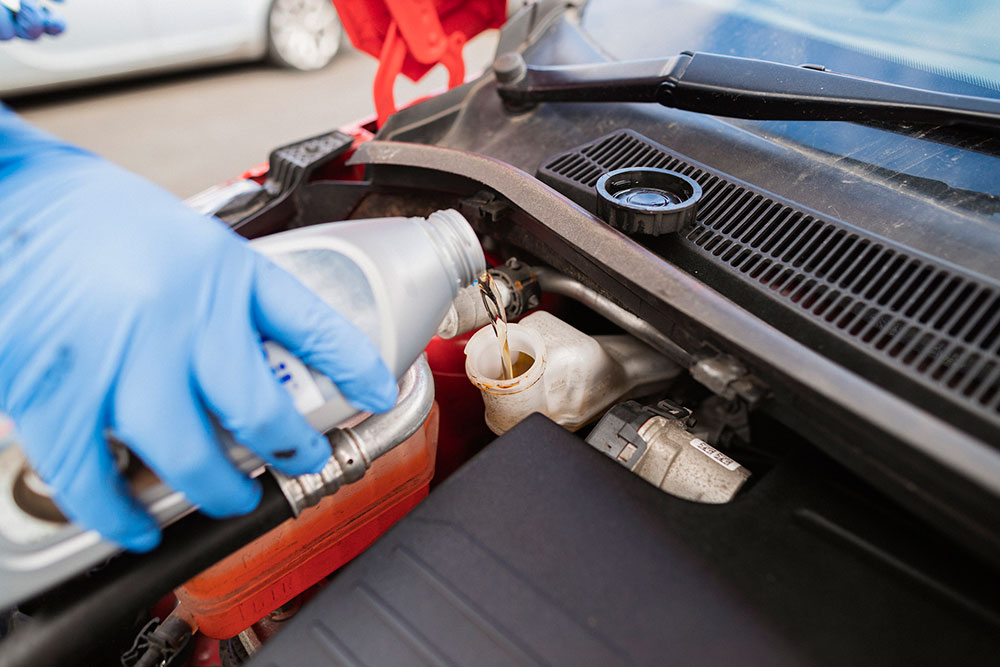What is brake fluid?
Brake fluid is one of the most important but least considered fluids in the car.

Brake fluid transfers the effort applied to the brake pedal by the driver's foot to the components that stop the vehicle.
The brake fluid used in most cars looks like oil, but it's quite different, and completely incompatible with oil.
Brake fluid is very sensitive to contamination and something as simple as dipping an oily finger into a brake fluid reservoir will contaminate the system, potentially causing unexpected brake failure.
Over time, brake fluid absorbs moisture from the atmosphere. This reduces its boiling point and corrodes brake system components.
Heat generated by the brakes can cause water-logged fluid to boil, resulting in sudden and unexpected brake failure, which is why it must be changed at regular intervals.
Most vehicle manufacturers recommend change intervals of around two years, irrespective of kilometres travelled.
Grades of brake fluids
Brake fluids are categorised by a Department of Transportation (DOT) number which defines the fluid’s characteristics and boiling point.
- DOT 3 or 4 fluids are common.
- Always check the vehicle's handbook before buying brake fluid, as some manufacturers have specific requirements.
- In theory a DOT 4 fluid can be used in place of a DOT 3 fluid. However, in practice this isn't always the case as some brake system materials are incompatible with fluids other than those specified.
- A DOT 3 fluid should not be used where a DOT 4 fluid is specified due to their different boiling points.
- DOT 5 fluids are silicone based, don’t absorb water, don’t mix with conventional fluids and won’t damage paint. They are more compressible than conventional fluids and can produce a ‘spongy’ pedal feel. They are generally only used in high performance applications such as motorcycles and are not generally suitable for anti-lock brake systems.
- DOT 5.1, and its variants, offer many of the performance benefits of DOT 5 silicone fluids, including a high boiling point, without being a silicone fluid. They have a broader application than DOT 5 fluids.
Mineral oil
Rolls Royce and Citroen are two manufacturers that don't use conventional brake fluids in some of their models, instead specifying a mineral oil.
Mineral oil is not compatible with conventional systems and will severely damage the system if used.
Similarly, systems designed for mineral oils will be damaged by conventional brake fluids.
Storage and handling
Brake fluid is particularly damaging to paintwork so never attempt to mop up, wipe or rub spills. Spills should be immediately flushed away with plenty of water.
Due to its affinity for moisture don't use fluid that has been stored for long periods after opening. It's preferred to use fluid from a sealed, previously unopened container.
Warning signs
It's normal for brake fluid reservoirs to require an occasional top up, however, any vehicle demanding frequent refilling needs professional investigation as this indicates the development of a fluid leak.
Related topics
Things to note
The information in this article has been prepared for general information purposes only and is not intended as legal advice or specific advice to any particular person. Any advice contained in the document is general advice, not intended as legal advice or professional advice and does not take into account any person’s particular circumstances. Before acting on anything based on this advice you should consider its appropriateness to you, having regard to your objectives and needs.
Insurance Products (excluding Travel Insurance) are issued by RACQ Insurance Limited ABN 50 009 704 152 (RACQI) and arranged by its agent, RACQ Distribution Services Pty Ltd (RDS) ABN 35 116 361 650, AFSL 567130 and RDS' authorised representatives (including RACQ Operations Pty Ltd ABN 80 009 663 414, AR No. 234978 (RACQO). Conditions, limits and exclusions apply. RDS and RACQO are in the RACQ group of companies. One of the companies in the RACQ group of companies has a minority shareholding in RACQI.
RDS and RACQO have not taken your personal objectives, circumstances or needs into account when preparing advice regarding insurance products and you will need to consider whether the advice is appropriate for you. Read the Product Disclosure Statement (PDS) and any applicable Supplementary PDS before making a purchase decision on this product. You can also access our Target Market Determinations on this website. RDS receives a commission from RACQI for the policies it arranges. RACQO receives fees paid for services it provides to RDS. Further details about remuneration are available on request prior to purchasing.
Banking and loan products issued by Members Banking Group Limited ABN 83 087 651 054 AFSL/Australian credit licence 241195 trading as RACQ Bank. Terms, conditions, fees, charges and lending policies apply. This is general advice only and may not be right for you. This information does not take your personal objectives, circumstances or needs into account. Read the disclosure documents for your selected product or service, including the Financial Services Guide and the Terms and Conditions, and consider if appropriate for you before deciding.
Except for RACQ Bank, any RACQ entity referred to on this page is not an authorised deposit-taking institution for the purposes of the Banking Act 1959 (Cth). That entity’s obligations do not represent deposits or other liabilities of RACQ Bank. RACQ Bank does not guarantee or otherwise provide assurance in respect of the obligations of that entity, unless noted otherwise.
RACQ Bank subscribes to the Customer Owned Banking Code of Practice which establishes higher standards than the law requires. The Code reflects modern consumer expectations and developments in approaches to issues such as consumer vulnerability, guarantors, and supporting customers through financial hardship. Please read our Customer Owned Banking Code of Practice page for more information.
RACQ Operations Pty Ltd (ABN 80 009 663 414 AR 000234978) and Members Travel Group Pty Ltd (ABN 45 144 538 803 AR 000432492) are acting as an Authorised Representative of the issuer of the insurance, Tokio Marine & Nichido Fire Insurance Co., Ltd. (ABN 80 000 438 291 AFSL 246 548). Any advice set out above is general in nature only, and does not take into account your objectives, financial situation or needs. Before purchasing any travel products, please consider the RACQ Travel Insurance Product Disclosure Statement (PDS) and the Target Market Determinations (TMDs) that apply to these products. Whilst the PDS outlines the Terms and Conditions of these products, the TMDs outline the intended class of customers that comprise the target market for these travel products. This will allow you to consider which products best suit your objectives, financial situation and needs and consider the products appropriateness to your personal circumstances. TMDs also outline matters involving the distribution and the review of these products. The PDS, Supplementary PDS and TMDs for each travel product can be found here.
